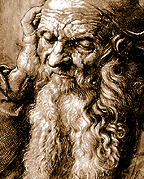
|
by Peg Aloi
Noon. The stoop-shouldered man is seated upon a hill in his south pasture. He knows the wee folk have been teasing his cattle, coaxing them to eat briars which sour their milk, and tripping them up so they fall headlong into the bog. He came here with new-baked bread, and clover honey: an offering. He remains seated on the fairy mound, his eyes narrowed to slits so that he might see their shimmering bodies, his ears opened wide so that he might hear their soft, sensuous music. If they accept his gift, they may one day consent to show themselves, to speak with him, maybe to dance in a ring before his amazed eyes. For now, the man is still and quiet, with the Midsummer sun high overhead, as he waits, respectfully, expecting nothing. Dusk. The woman stands on the riverbank, o'ershadowed by willow trees, weeping. Her tears are for a babe, born into her hands this day, too weak and malformed to survive. She comforted the mother with herbs and kind words, then left her to sleep, exhausted from her labor and her grief. Tomorrow, she will administer more herbs to speed the mother's healing, and will wrap the babe in linen cloth, with white rosebuds and lavender, before he is laid to rest. For now, the midwife gazes at the water, and feels her heart fill with the rushing tides of five decades of living, and mourns the babe who will never know the touch of lips to his own, or the sinewy back of a horse beneath his thighs, or the sheep-scented roughness of a new woolen cloak, or the crimson sweetness of red raspberries, plucked and eaten at twilight.
THE WITCH IN THE WOODS There have been healers since time immemorial: male and female, young and old, some gifted with prophetic or magical powers, some merely adept at reading the symptoms of the body. In ancient Egypt, those who acted as "doctors" also prepared mummies for burial in tombs. In Greece and Rome healers were skilled in massage, botany, and herbalism. Both men and women held these posts, though men were generally regarded as the more educable of the two, and so were permitted access to more avenues for learning. In medieval and Renaissance Europe, the healer-mystics were men, while the midwife-herbalists were women. Both co-existed as they practiced their crafts, but the Great Plague caused much doubt as to the true efficacy of the medical profession; neither the doctor nor the sorcerer could save anyone. Interestingly, those who worked with herbs and plants often proved immune to plague, because of their exposure to the volatile essential oils which acted as anti-septic, anti-bacterial, anti-microbial, and anti-viral agents against germs and disease, worsened by the urban filth, poor personal hygiene, and inadequate sanitation practices of the time. Perfumers and apothecaries were particularly well-protected. Village herbalists therefore were thought to be very powerful, because of this seeming mantle of protection against one of the most deadly epidemics in human history. Power, however, often breeds suspicion, and it is difficult to speak of the archetype of the European village healer without speaking of persecution. The rise of the Church during this period (roughly the 12th-16th centuries) ignited a vast campaign of hatred against women, and those who practiced the healing arts were accused of witchcraft, just as other citizens were accused of heresy or other crimes. In Germany, France, Italy and the British Isles, these accusations became occurrences as commonplace as birth, death or marriage. Though far removed from the larger townships where more sensational criminal trials prevailed, the smaller hamlets and villages were nevertheless subjected to this holocaust; visited by Church dignitaries and magistrates who specialized in ferreting out witches and warlocks, these simple country folk became swept up in the cynical, pathological obsession that became the European witchcraze.
|
Contact Us
All material ©1999 Obsidian Magazine. All rights reserved.
 Dawn. The grey-haired woman treads lightly through her cottage garden, dewdrops soaking her worn leather boots. She stops periodically, kneels down, and gently cuts some leaves or stems with a sickle knife. As she places each cutting into her basket, she touches the plant with gentle, gnarled hands, thanking it and telling its newly-shorn edges to mend quickly. The sun, just appearing over the horizon, begins to break through the trees, and she turns towards it, the butter-colored light softening the crags in her ancient, knowing face. Her ginger tomcat with the brindled legs twines 'round his mistress' feet, mewling for his breakfast.
Dawn. The grey-haired woman treads lightly through her cottage garden, dewdrops soaking her worn leather boots. She stops periodically, kneels down, and gently cuts some leaves or stems with a sickle knife. As she places each cutting into her basket, she touches the plant with gentle, gnarled hands, thanking it and telling its newly-shorn edges to mend quickly. The sun, just appearing over the horizon, begins to break through the trees, and she turns towards it, the butter-colored light softening the crags in her ancient, knowing face. Her ginger tomcat with the brindled legs twines 'round his mistress' feet, mewling for his breakfast.
